Can you Handle things?
Over the years I have seen how rehandling existing handles can markedly improve the efficiency and energy of hand tools and customising them reduces the energy it takes to use them. The ultra-inexpensive Spear & Jackson 9500R traditional skew back panel saw, 22″ x 10pts costing £16 with free delivery via Amazon.co.uk is the most surprising handsaw you will find for your money — and take it from me, I am not introducing a cheap feeling handsaw but one designed and made to last for a lifetime of full time, every day, all-day use at that. Don’t be put off by the incredibly low price either as it does not reflect a low-quality handsaw. Why so cheap? No, it’s not cheap labour but low manpower need. As it is with 95% of making any and all tools these days, manpower for manufacturing is mostly replaced by AI and CNC so people standing at machines and controlling them is almost non-existent. Saws are one such tool and especially so. A CNC can rout out two hundred handles in a matter of minutes and spray finishes with water-based finishes takes about the same. Saw plates punch out and file teeth without a hand ever touching the blade or file so it is no surprise that a handsaw should indeed be such a low priced tool if you think about it. I doubt whether there is more than a minute’s human effort in the making of a handsaw anymore and this Spear & Jackson really is a workhorse with the punchiness of the very best panel saws. I know! It sounds a bit demoralising, but there is not really too much to making handsaws. Gone are the days of uniquely shaped handsaw handles where a man stood at a vise and shaped and scraped the handle by hand.
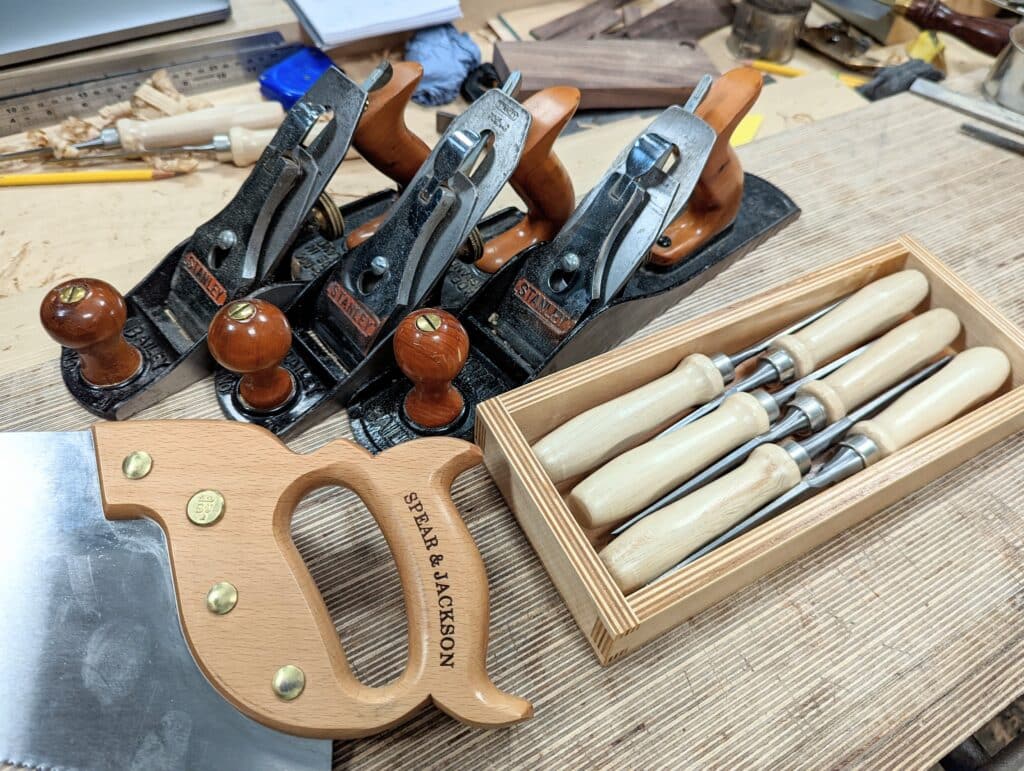
I have been using my Spear & Jackson 22″ panel saw daily for several years now and it sharpens very well by hand and holds an edge like its so-called premium versions costing over £200 plus. Whether you reshape the handle or not is purely a matter of preference rather than need. Without it it feels fine, the saw is very well made, finished nicely and the teeth hold an edge as well as the best. My earlier blog post on how to transform the handle for both comfort and functionality tells you how to do it. Here’s the link to that end, but . . .
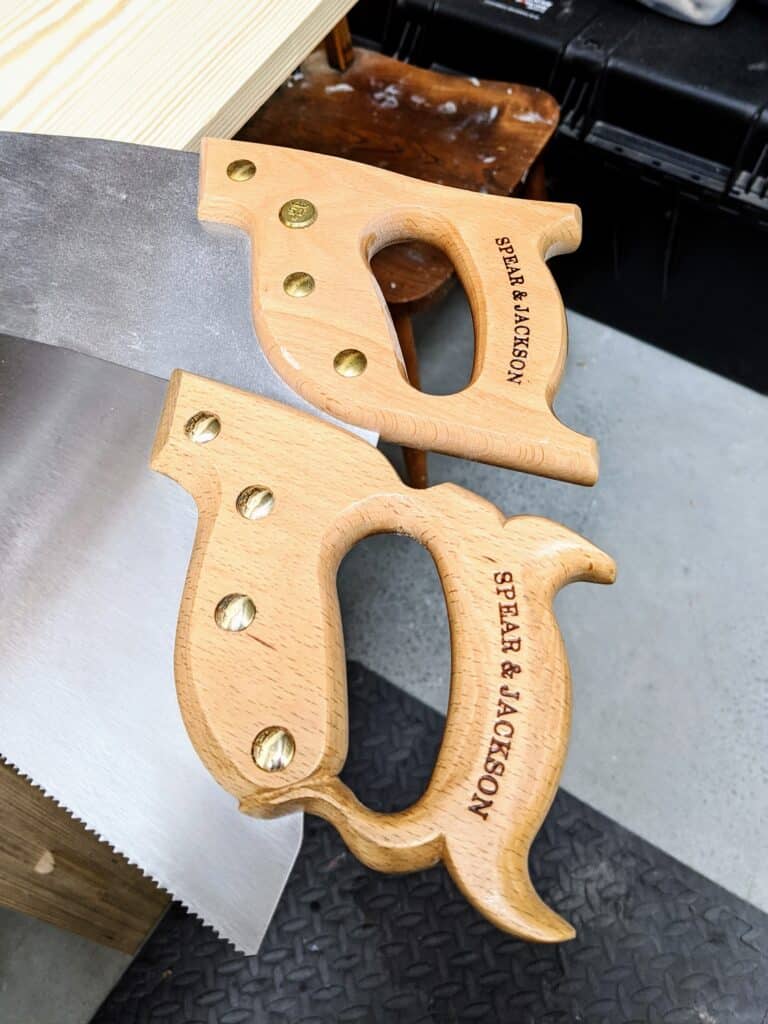
. . . I have refined a handsaw with a simpler less time-consuming profiling that is much quicker and easier to do without taking the handle off or replacing the expensive screw caps with very overpriced replacements. It looks and feels just great and before anyone tells me you can’t tighten the screw caps because there’s no slot, that’s not true at all. The tighten just fine with the single tap of a hammer on the cap. Here is the outcome of my simpler handle change. I think it looks and feels just fine.
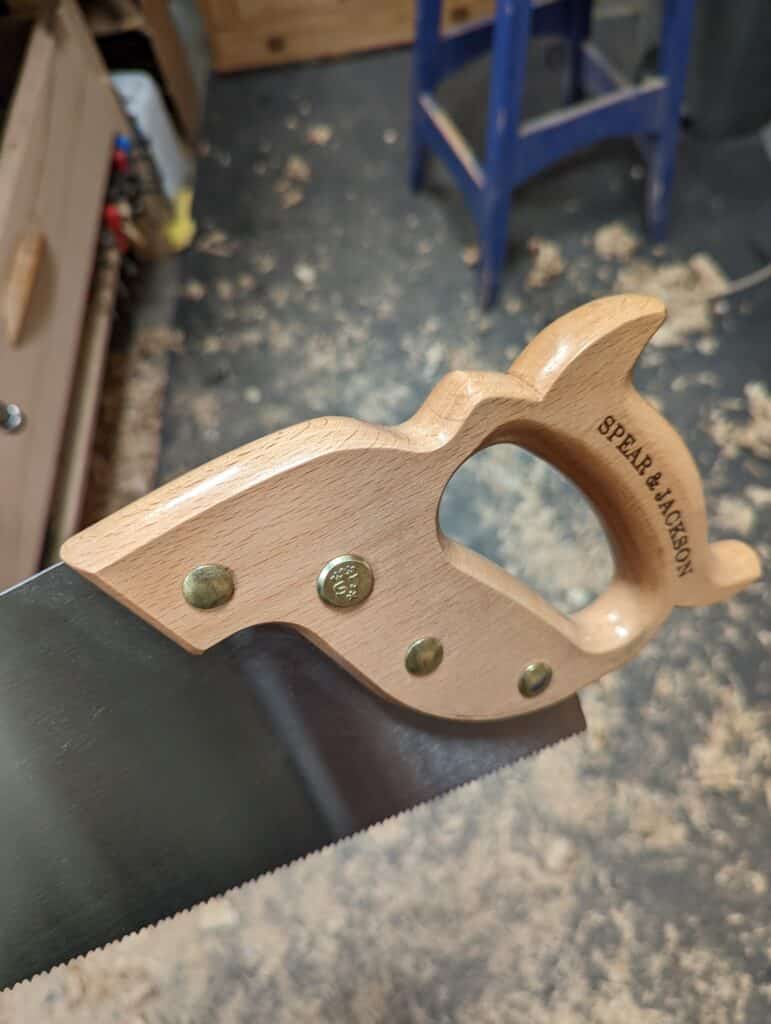
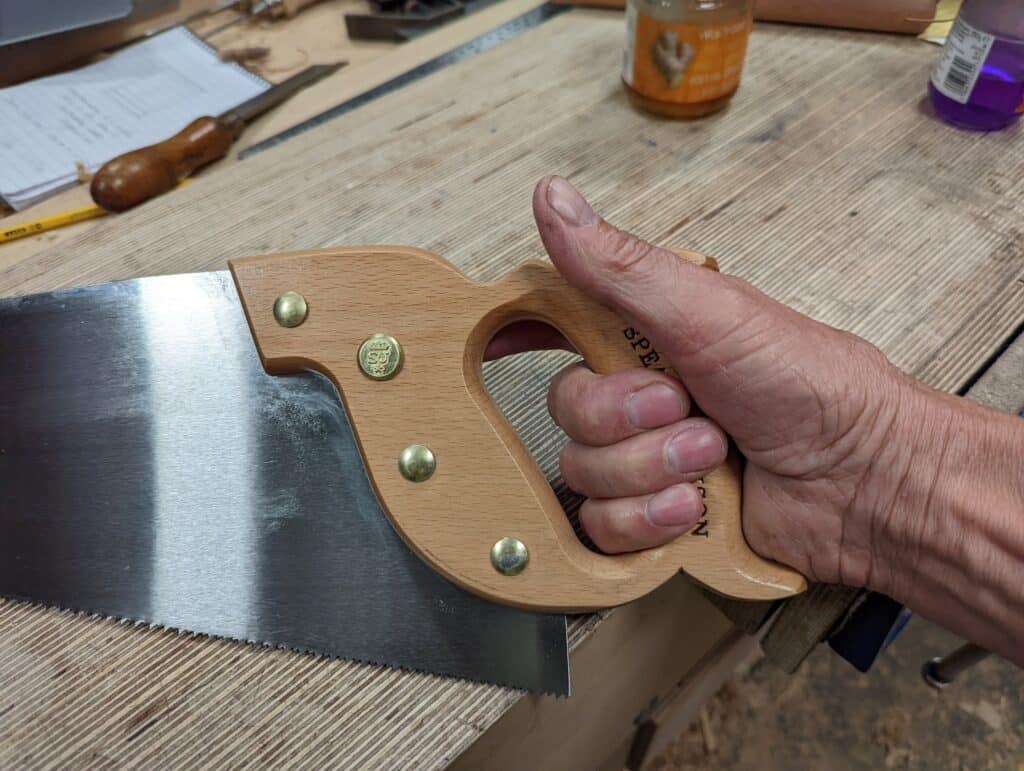
There are various other S & J saws including tenon saws of different lengths too and these are fine for reworking as well. I have different blog posts on how to refine such saws to finesse them if needed so you really do not need to spend too much on saws to get a really decent lifetime version. All you need for a good saw is decent steel and solid wood for the handle. You get both in these S&J versions and no I don’t get a kickback from S&J so I am free to speak my mind always.
So why go to the trouble of developing a wooden handsaw handle further instead of just buying one with an ergonomically developed one made from plastic with rubberised inserts for grip? Well, you cannot really compare the two types because one, the wooden handled version, is designed and intended to last about a hundred years if you use it every single day of the week, week in and week out for many hours a week. The plastic handled version on the other hand has impulse-hardened teeth that cannot be resharpened once hardened and are designed to keep you coming back for more throughout that lifetime I speak of. The sharpness of these lasts four to five times longer than that of the resharpenable ones so for someone who only uses a saw every few months these will be the better choice. For serious woodworkers like us, the resharpenable ones maximise savings and quality of life. I (and you with a little practice) can sharpen a handsaw like this in just four to five minutes and a £10 saw file will sharpen saws like this about 30-35 times no problem.
Now it did take me an hour to reshape the saw handle. Factor into that that I thoroughly enjoyed doing it, I made the time to do it and I was able to watch the Queen’s 70th Jubilee Celebrations while I did so, it was an utter win-win. The tools? A combination of a Shinto saw rasp, a small half-round rasp, a flat 10″ file, a coping saw, a thin card scraper (Veritas), and a 1″ chisel. I used abrasive paper to sand the whole and then applied three good coats of shellac before buffing out with 0000 steel wool and soft furniture polish.
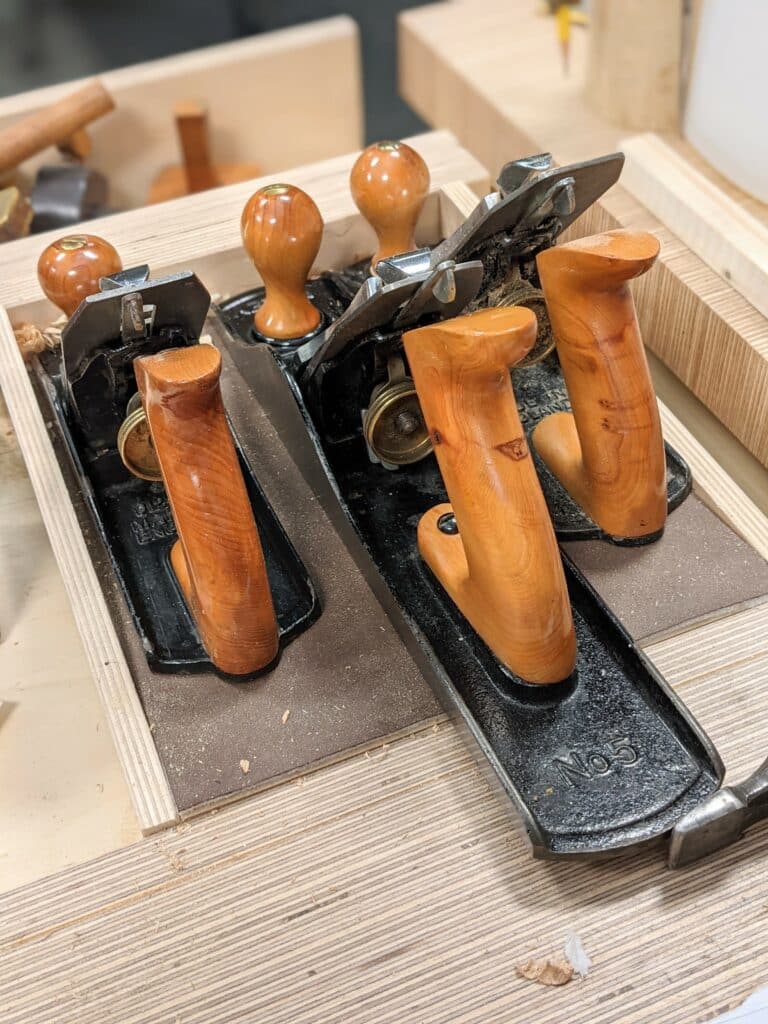
Rehandling planes without a lathe is a video you might want to catch on my YouTube channel here. Changing this will also power up your hand tools to fit you rather than rely on the generic versions that come with the plane. I also have shaped the two on my #4 planes to differentiate between one I have set up for a scrub plane and the other my regular smoothing plane. As soon as my fingers touch the plane handles `i can tell which is which. All in all I have fitted out three planes with yew handles but the wood is inconsequential so you can make them from any wood or just reshape the existing to suit your hands.
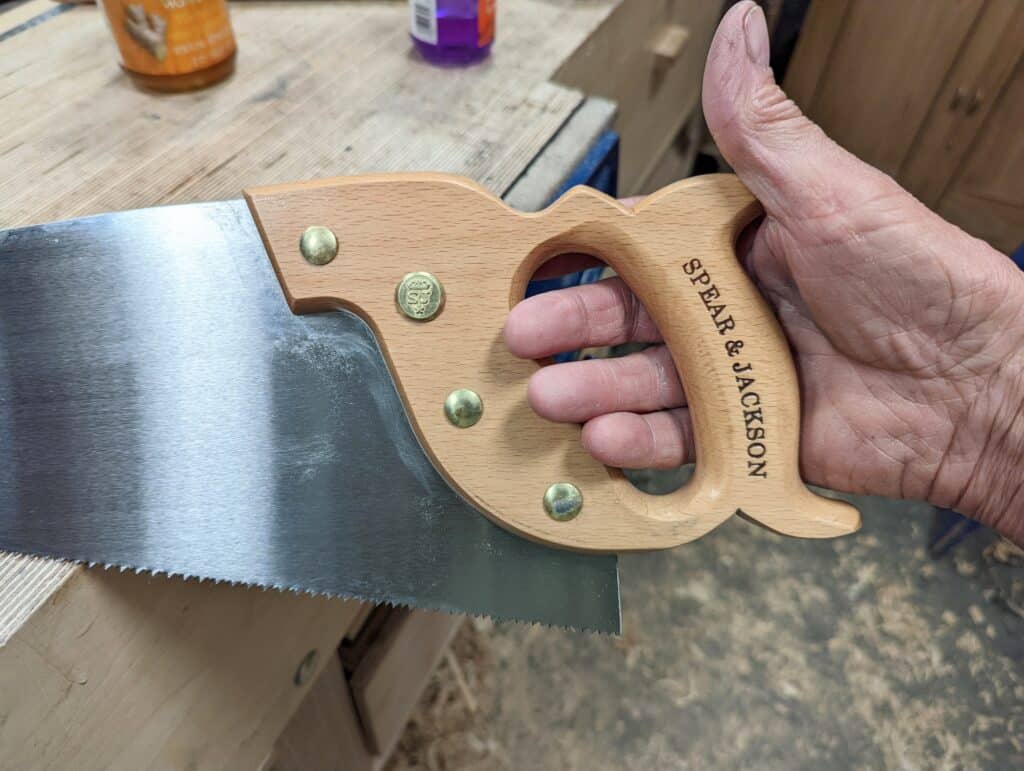
So these are my recently upgraded chisels replete with storage tray to fit my workbench and keep the chisels close to hand and in order. This is well worth doing though doing eight can take time. Just do a couple at a time and it goes fast and fills in time you might have spare in the evening for being creative.
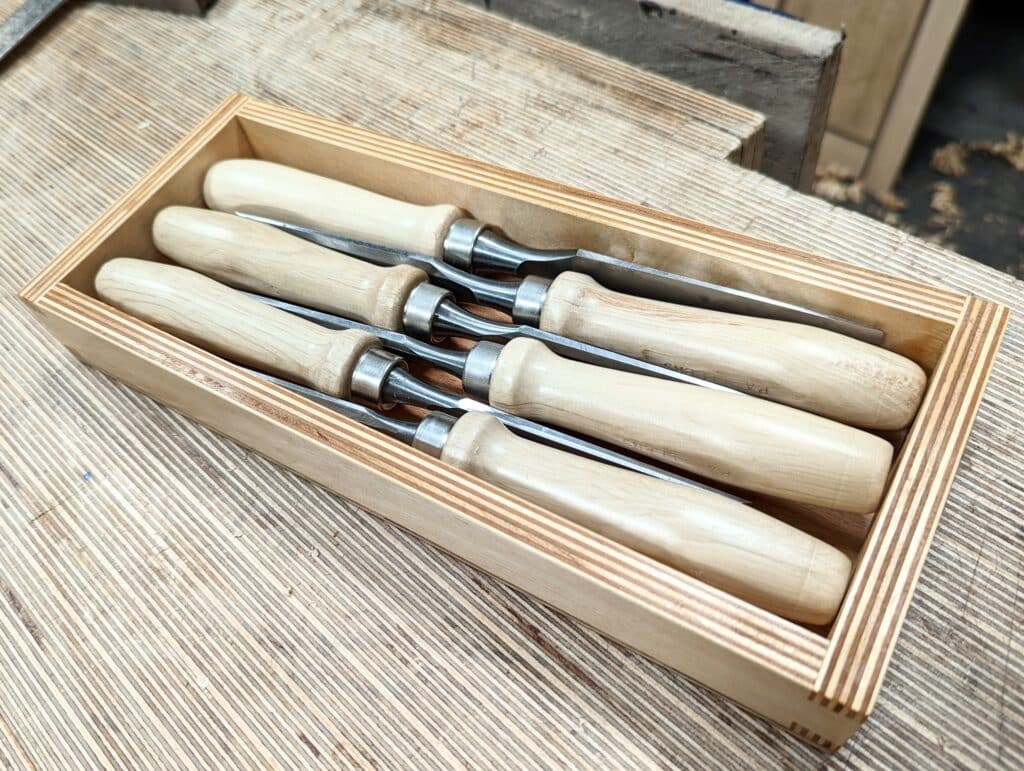


Thanks Paul. Based on your advice, I purchased S&J saw. It is an excellent saw. I think I spent about 4 hours making the handle nice. In all honesty, the photo you show in this post is enough for most folks to free hand the lines in and use the tools you outlined in the article.
Do you have a saw tooth set you could recommend for me to purchase? I have filed the teeth (super easy following how you outlined it in your book). I know you have used things such as nail sets, screws, etc. I’d like to get a proper saw set and just don’t know which one to get or if it really matters. Many thanks.
Long before i met you, I had purchased a tooth hardened saw. Comes in handy to bring to the lumber store, etc. When it reaches the end of its life, I am going to take off the plastic handle and see if I can’t unharden the teeth with a torch. Not much to loose at that point. Rather than use a torch, could I just try sticking the unhandled blade in an oven at 200 C for a few hours to achieve the same effect?
I have always used an Eclipse sawset. I wrote about it in my book Essential Woodworking Hand Tools which I think you have.
“[…], could I just try sticking the unhandled blade in an oven at 200 C for a few hours to achieve the same effect?”
Only the teeth are hardened, so even with annealing to reduce the hardness to make re-sharpening possible, after a few sharpening-sessions you get to the softer, unhardened part of the saw plate. Said parts likely won’t hold much of an edge as they’ve never been hardened in the first place (so annealing will do nothing there).
The whole saw plate was definitely hardened and tempered. Then they hardened the teeth. Because they know no one’s sharpening hand saws today. They’d rather folks didn’t. It’s better for business if they simply buy new saws. But if the whole plate was soft like you say it is then it’d be like a rubber gag saw. It’d kink right up when you tried to use it. No one would be too happy about that either. So that just can’t be. They can screw their customers but there’s limits.
For maybe a year I have been gently keeping my eyes open for a saw set.
Recently picked two up for the princely sum of $2.
With a sense of quiet excitement, went home, into the shed and went to set a saw… only to realise they were both rip cut saws with no set! 😊 😊
No doubt George would have laughed. And I progressed from book learning to real world learning…
I am not sure what you are saying here, Paul. Rip cuts need set just the same as crosscut saws.
Thanks Paul. Since I can’t recall you had mentioned the specific saw set in your book (which I do have), I guess that means its time to read it again. Good homework assignment.
Hello Paul,
Firstly thank you for all these diamonds of knowledge you’ve gained and share with us (saving us the misery of learning the hard way). As my tool selection grows so does the type of project I can complete. The ‘rag in a can’ I’ve become quite fond of and also the Stanley No.4 plane seems to be in my hand more than any other. I do have a saw but I feel it’s of a lower quality than your S&J suggestion. I’m contemplating buying 2 of the 22″ S&J saws and following your video tutorial setting one for rip and the other for crosscut (worth doing in your opinion?). I may put 2 S&J 12″ tenon saws in my basket whilst I’m at it and do the same rip/cross pattern. A lot more frivolous than I usually work as I’ve always hunted for an old used bargain tool with a story to tell (but it’s my birthday money). My question is do you have the same positive thoughts on the S&J brass backed tenon saws?
With regards to the Queen’s jubilee (and music concert), I’d have been more than happy to see a short video
from you being beamed onto Buckingham palace! A missed opportunity I feel.
Kindest regards
Simon
Just found a paragraph in your text where it answers my question. Must have missed it on the first read (was keen to go out to my workspace and finish my second three legged stool). Decided to go with one 22″ and one 12″ tenon saw and file them both to a rip cut pattern.
Thanks for helping me to rekindle my passion for hand-tool woodworking.
Kind regards
Simon
I like how you eliminated the small flourish at the bottom of the saw handle. That allows reshaping with the handle still on the saw. Thank you.
thanks for your ‘setting me straight’ on tihs paul, much appreciated.
i erroneously thought that rip cut saws were meant to have no set on them – so i thought i couldnt set the rip cut saws, and would have to buy a cross cut saw before i could set something.
but now I realise i can (and should) set both rip and cross cut saws.
thanks again, cheers
Great. Glad to help.
Hello Paul,
a little question about the finish applied on tool handles.
On my restored #4, I put linseed oil + furniture polish (just because I had no shellac at the time). The plane is very pleasant to handle, even over long periods of time. Shellac finish looks slightly more “slippery”. Or is it just a false idea of mine ?
I like your “simpler” reshaping of the S&J handles. I will do it on my 12″ tenon saw. The original handle is really uncomfortable, but after a few years the screw caps still hold the blade perfectly, so why remove them !
Thanks and best regards
Hey Paul,
How about doing a blog about the blue shop stool?
I’ve always liked the look of it….
Pax,
Jeff
This post was just over a week ago, but I crept under the wire and bought the saw. Got two in fact and I’ll set up one for ripping. 37% off RRP! Great spot, thanks Paul.
😁
Also many thanks for the heads up on the Shinto rasp. Mine just showed up so I had to try it of course.
Haha, wow – that thing is deadly!
Do you think my luck will hold if you fill in my lottery ticket 😆??
Just kidding; thanks and have a great day.
I have one of those Shinto rasps and color me unimpressed. Then again I do have a rotary rasp in a pneumatic die grinder to compare it to. So that colors my judgement some. I did just pick up a 14″ Nicholson farriers rasp in a basket of junk that has some bite to it.
I’m not sure what “color me unimpressed.” means, Paul. Perhaps a typo or autocorrect. I very much doubt that any Nicholson farrier’s rasp can achieve a small fraction of the Shinto rasp which cuts wood very rapidly even on the ‘soft’ side and decidedly better than any mass-made production rasp can.
Don’t know if you ever tried one Paul but I used to have a thing called a Dreadnought file that I used mainly for shaping aluminium and other metals. I remember it being pretty effective on hardwood too. I lost it years ago so I just went online and bought a new one. I still do a lot of metalworking so one way or another it’ll get used. Happy days!
I’ve made saw handles, plane totes, chisel handles. Probably other things I’m not remembering now too. It’s always a satisfying experience to make a tool handle that feels good in the hand. So I recommend everyone give it a shot. You just might make something better than you think you can.
Agreed on that. A very satisfying thing as you say.
Somebody gave me a broken cricket bat a while ago. Not sure what it’s made from but it yielded two really nice file handles so far!
Hi Paul
Could you or someone on your team create a template for modifying the S&J 24” handsaws?
Rex Kruger did this with the handle on the S&J “Tenon” saw.
It’s colour coded to show areas to leave, remove, round/shape….
It would be very helpful…
Thanks,
Jeff